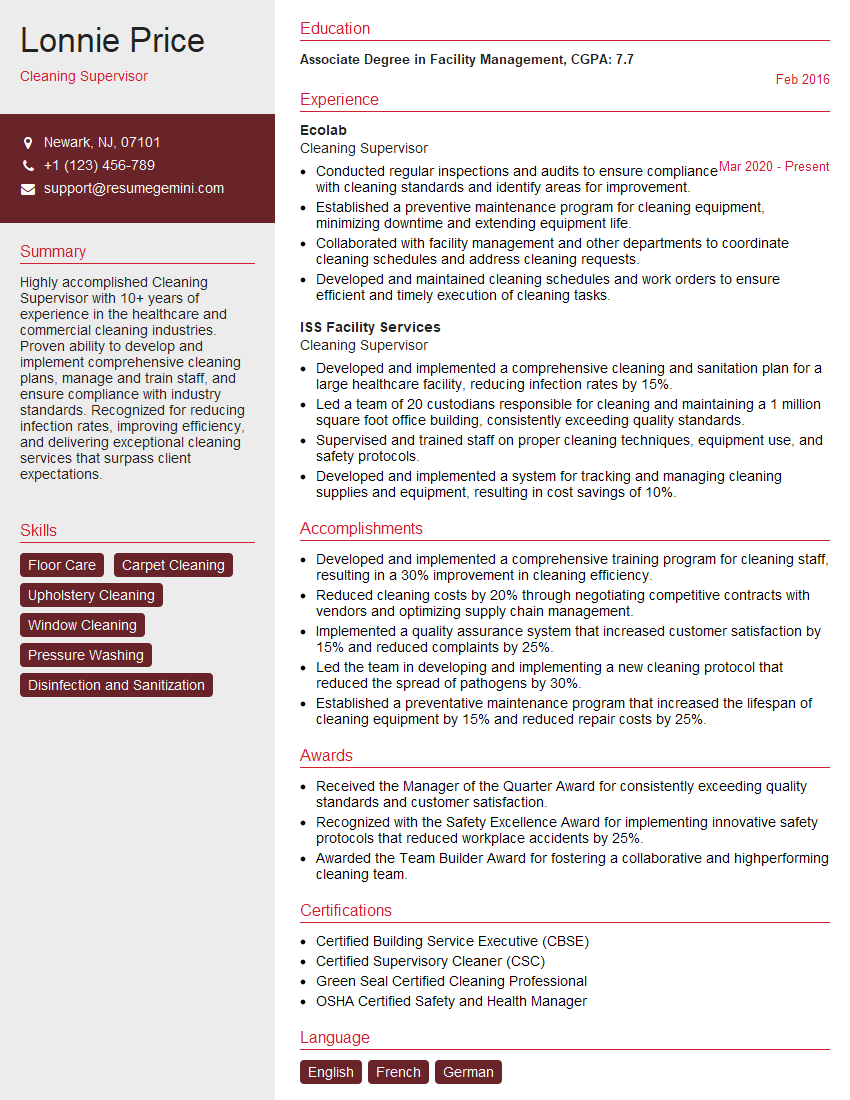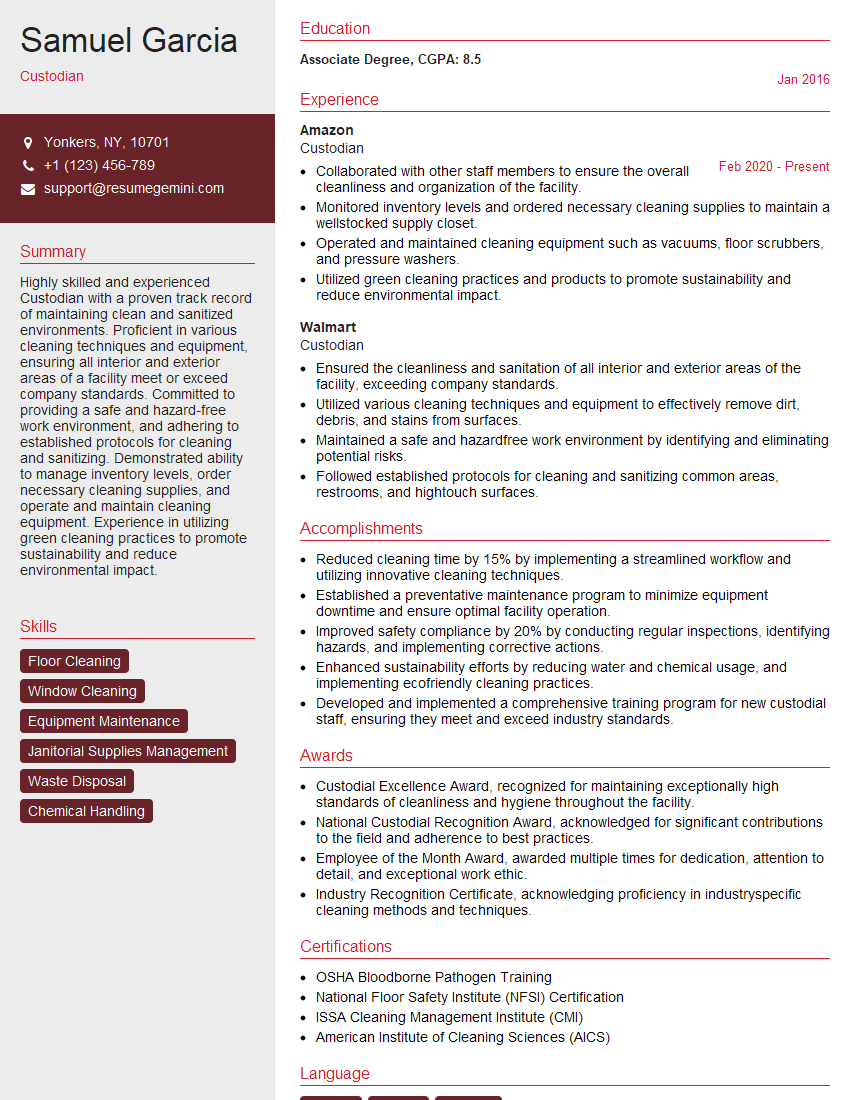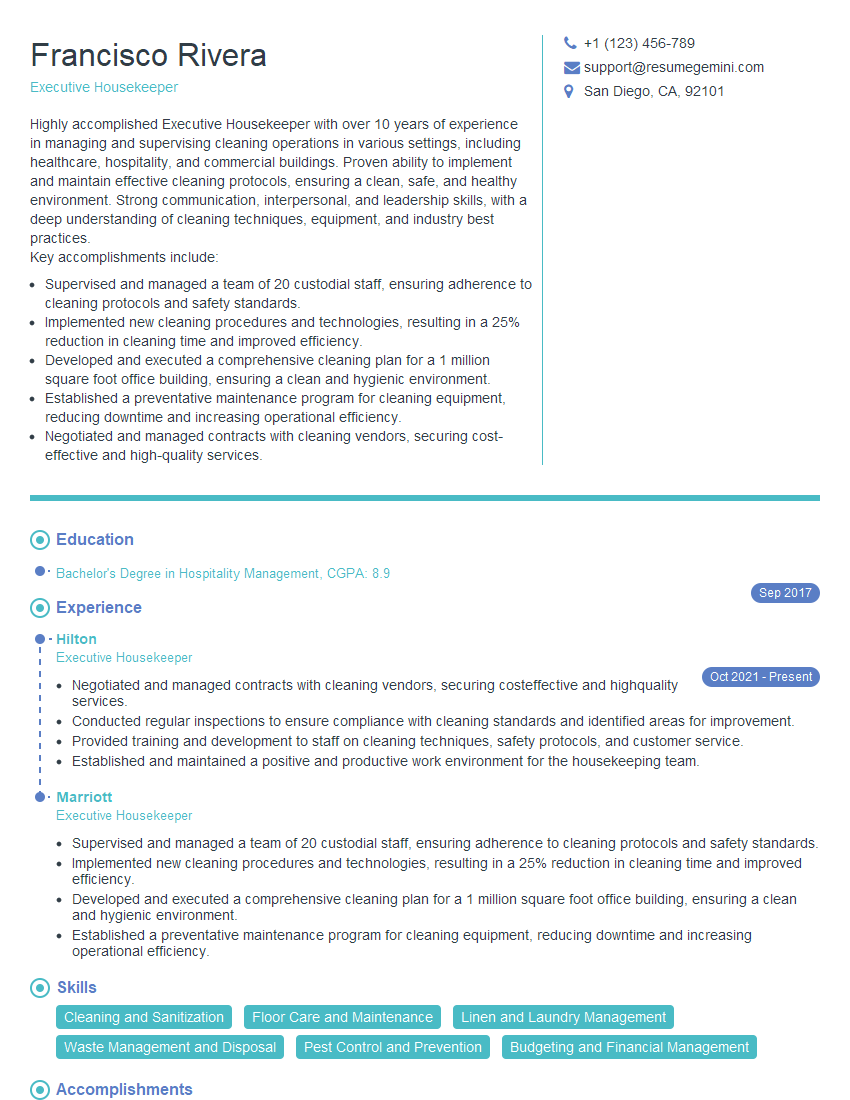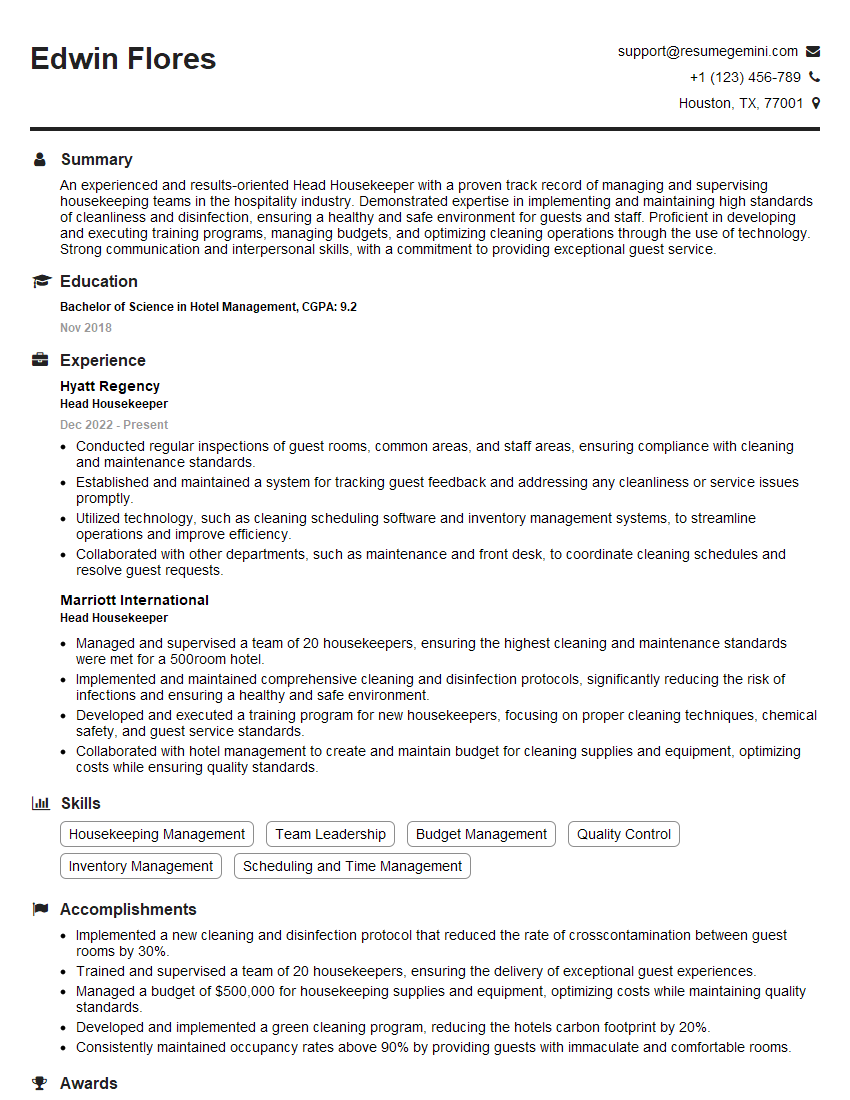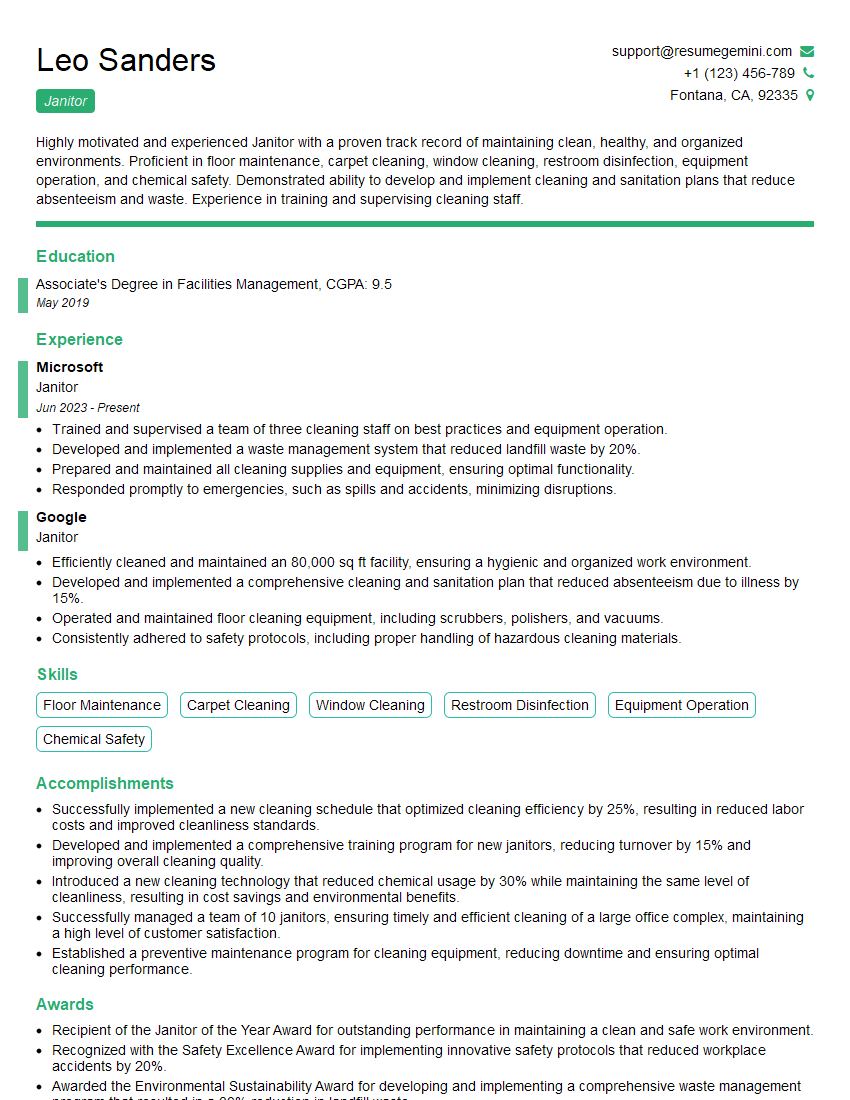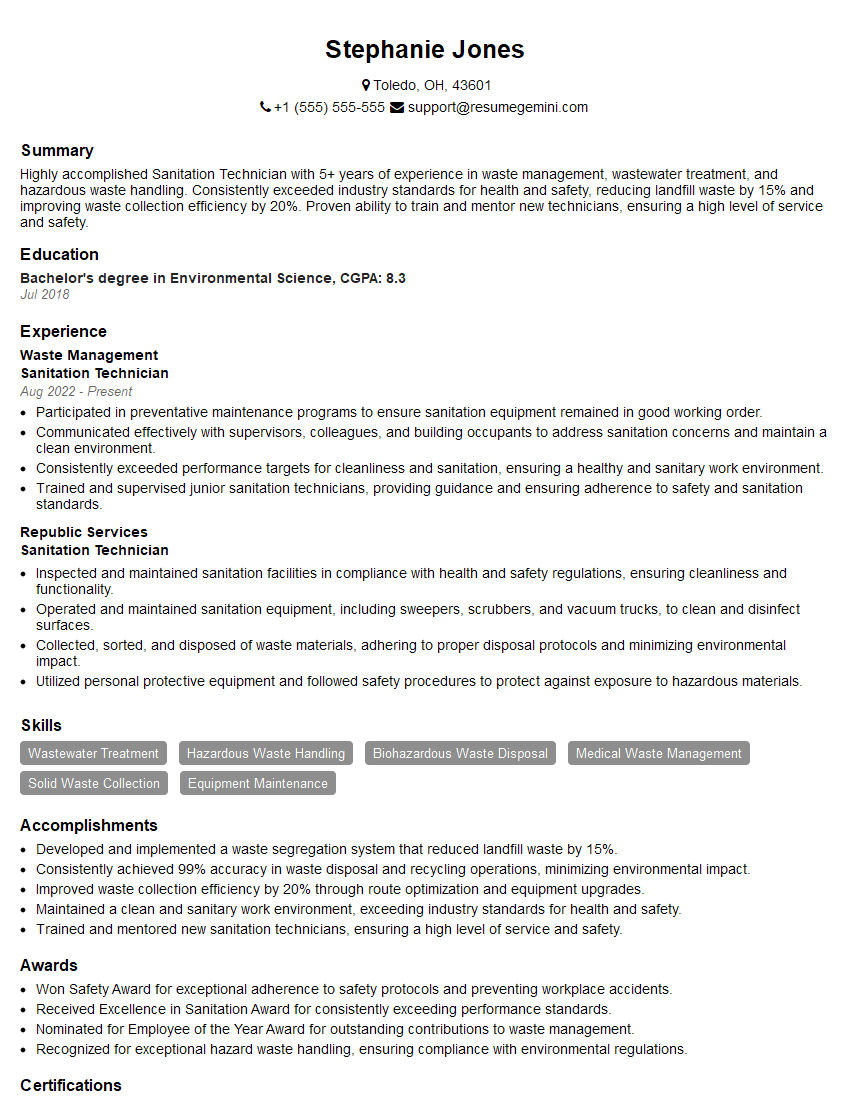Every successful interview starts with knowing what to expect. In this blog, we’ll take you through the top Microfiber Cleaning Techniques interview questions, breaking them down with expert tips to help you deliver impactful answers. Step into your next interview fully prepared and ready to succeed.
Questions Asked in Microfiber Cleaning Techniques Interview
Q 1. What are the benefits of using microfiber cloths compared to traditional cleaning methods?
Microfiber cloths offer significant advantages over traditional cleaning methods, primarily due to their unique fiber structure. These incredibly fine fibers, typically a blend of polyester and polyamide, create an electrostatic charge that attracts and traps dust, dirt, and other particles. This superior trapping ability means you achieve a deeper clean with less effort and less cleaning solution. Unlike traditional cloths which often just smear dirt around, microfiber actually lifts and holds the grime. This results in less streaking, cleaner surfaces, and reduced environmental impact due to less water and cleaning agent usage.
Think of it like this: a traditional cloth is like a sponge—it absorbs some liquid, but it also leaves behind residue. A microfiber cloth is more like a magnet—it actively attracts and holds onto the dirt, leaving a cleaner surface behind.
Q 2. Explain the different types of microfiber cloths and their appropriate uses.
Microfiber cloths come in various types, each designed for specific applications.
- General-purpose cloths: These are the workhorses, ideal for everyday dusting, wiping, and cleaning most surfaces. They usually have a split fiber structure for optimal dirt pickup.
- Polishing cloths: These cloths have a very fine fiber structure for a streak-free shine on polished surfaces like furniture and glass. They’re softer and often made of 100% polyester.
- Cleaning cloths: These are more absorbent and thicker, suitable for heavy-duty cleaning tasks like scrubbing floors or cleaning spills. They are often more durable and can withstand more frequent washing.
- Specialty cloths: These are designed for specific uses, such as those treated with antibacterial agents for kitchen and bathroom cleaning or those designed for delicate surfaces.
For example, I’d use a polishing cloth for cleaning a glass coffee table to prevent streaks, but a cleaning cloth for scrubbing a kitchen counter covered in baked-on food residue.
Q 3. How do you determine the appropriate cleaning solution for various surfaces using microfiber?
Selecting the right cleaning solution is crucial for effective and safe microfiber cleaning. The surface material dictates the choice. For example, you wouldn’t use a harsh bleach-based cleaner on a delicate wood surface.
- Glass and mirrors: Use a simple solution of water and white vinegar (a roughly 50/50 mixture).
- Stainless steel appliances: A diluted dish soap solution is usually sufficient.
- Wood surfaces: Use a wood cleaner specifically designed for your type of wood, and always test in an inconspicuous area first.
- Hard floors: A diluted all-purpose cleaner or specialized floor cleaner, depending on the floor material (tile, hardwood, etc.).
Always avoid abrasive cleaners and harsh chemicals that can damage the microfiber cloth or the surface being cleaned. It’s always best to start with the least aggressive solution and increase the cleaning power as needed.
Q 4. Describe your process for cleaning a heavily soiled surface with microfiber.
Cleaning a heavily soiled surface requires a methodical approach. Here’s my process:
- Pre-treatment: If the surface has dried-on residue, pre-treat the area with a suitable cleaning solution, allowing it to sit for a few minutes to loosen the grime.
- Section Cleaning: Divide the surface into smaller sections to maintain a clean work area and avoid spreading dirt. Don’t try to clean the entire surface at once.
- Apply Cleaning Solution: Spray the cleaning solution directly onto the cloth, not the surface (to prevent over-saturation and streaking).
- Scrubbing: Use gentle, overlapping strokes to clean the surface, replacing the section of the cloth as needed. For tough stains, you might need a bit more pressure, but avoid abrasive scrubbing that can damage the surface.
- Rinse and Dry: Rinse the cloth frequently in clean water and wring it out thoroughly. Once the surface is cleaned, dry it with a clean, dry microfiber cloth to prevent watermarks.
This systematic approach ensures thorough cleaning while preventing the spread of dirt and damaging the surface.
Q 5. How do you maintain and care for microfiber cloths to maximize their lifespan and effectiveness?
Proper care is essential for extending the life and effectiveness of microfiber cloths. Never use fabric softener, as it coats the fibers and reduces their cleaning ability.
- Washing: Wash your microfiber cloths separately (ideally in a mesh laundry bag) in hot water. Avoid using bleach.
- Drying: Air drying is preferred, as heat from a dryer can damage the fibers. If you use a dryer, opt for low heat.
- Storage: Store your cloths in a clean, dry place away from dust and debris.
- Inspect Regularly: Check your cloths for wear and tear, and replace them when they are significantly frayed or damaged.
Regular maintenance is key: I treat my microfiber cloths like any other valuable tool, ensuring their cleanliness and longevity.
Q 6. What are the safety precautions when using microfiber cleaning products?
Safety precautions are crucial when using microfiber cleaning products.
- Avoid Cross-Contamination: Use separate cloths for different cleaning tasks (e.g., kitchen, bathroom, general cleaning) to prevent the spread of bacteria.
- Proper Disposal: Dispose of soiled cloths properly; do not leave them lying around where they can pose a tripping hazard.
- Allergic Reactions: If you have sensitive skin, always test a small area before using a new cleaning solution with a microfiber cloth.
- Chemical Handling: Always follow the manufacturer’s instructions for any cleaning solutions you are using. Use appropriate safety gloves and eye protection when dealing with stronger chemicals.
Prioritizing safety in cleaning is vital not only to your health but also to the quality of your cleaning work.
Q 7. Explain the proper technique for using microfiber mops and how they differ from traditional mops.
Microfiber mops offer a significant upgrade over traditional string mops. They typically have a washable microfiber pad that can be attached and removed easily for cleaning and replacement.
- Technique: Use overlapping strokes, working your way from the furthest point of the room towards the exit. Overlapping prevents leaving streaks or missing areas.
- Rinse and Wring: Rinse the mop head frequently in a bucket of clean water, ensuring you wring it out thoroughly to prevent leaving excess moisture on the floor.
- Differences from Traditional Mops: Traditional mops often require a significant amount of water and cleaning solution, leaving floors soggy and requiring longer drying time. Microfiber mops require less water, resulting in quicker drying and better cleaning efficacy.
Think of a traditional mop as a broom that tries to clean with water, while a microfiber mop is a more efficient and effective way to clean and absorb dirt.
Q 8. How do you handle spills or accidents effectively using microfiber cleaning techniques?
Handling spills with microfiber is all about speed and the right technique. The key is to act quickly before the spill sets. First, blot – don’t wipe – the spill with a clean, dry microfiber cloth. Wiping spreads the spill. Blot gently, using a fresh section of the cloth as needed. For sticky spills, pre-treat with a suitable cleaning solution (diluted according to product instructions) and then blot again. After blotting, you may need to use a damp microfiber cloth to clean the area further, finally polishing with a clean, dry cloth for a streak-free finish. Imagine it like gently coaxing the spill up, rather than forcing it around. For example, a coffee spill on a wooden table would be dealt with by first blotting the coffee with a dry microfiber cloth to absorb the bulk of the spill. Then, a slightly damp cloth with a few drops of mild cleaner can be used to remove any lingering stain, followed by a final dry wipe.
Q 9. How do you ensure effective cleaning in hard-to-reach areas using microfiber tools?
Reaching those tricky spots requires specialized microfiber tools. For narrow crevices, consider using microfiber cleaning swabs or narrow microfiber cloths. These are often more effective than brushes for reaching into tight spaces and removing dust and dirt effectively. For cleaning hard to reach areas like behind appliances or under furniture, consider using microfiber dusters with extendable handles. These tools allow you to reach further without straining, and the microfiber itself traps dust effectively. For example, to clean the gap behind a refrigerator, I’d use an extendable microfiber duster, then follow with a microfiber cloth attached to a long cleaning tool for any stubborn dirt or grime. Microfiber mop heads designed for angles are useful for cleaning corners and hard to reach areas on flooring. Think strategically about your tools – the right tool for the job makes all the difference.
Q 10. What are some common mistakes to avoid when using microfiber cloths?
Common microfiber mistakes often stem from improper use or care. One big mistake is using dirty microfiber cloths. Microfiber works on the principle of trapping dirt; if your cloth is already full, it won’t clean effectively and may even spread germs. Always inspect your microfiber cloths before use to make sure they are clean. Another common mistake is using too much cleaning solution. Microfiber’s effectiveness is often enhanced with a slightly damp cloth, not a soaking wet one. Excessive moisture can cause streaking, especially on glass and polished surfaces. Finally, using the wrong type of microfiber for the job will lead to ineffective cleaning. For example, using a polishing cloth instead of a heavy duty cleaning cloth will not pick up stuck on food particles. Always choose the appropriate microfiber type for the task at hand. Improper washing and drying (use of fabric softener or high heat) can also reduce the effectiveness of the cloth and its lifespan.
Q 11. How do you ensure the proper disposal of used microfiber cloths and cleaning solutions?
Proper disposal depends on local regulations and the type of cleaning solution used. For simple water-based cleaning solutions, used microfiber cloths can be laundered as usual. It is important to separate your microfiber cloths from other laundry to avoid transferring lint to other clothing. For cloths soiled with hazardous materials or strong chemicals, follow the manufacturer’s instructions for disposal. Ideally, hazardous or contaminated cloths should be disposed of separately, and you should check with your local waste management authority for specific guidance on disposing of these items safely. Always follow the Safety Data Sheets (SDS) associated with any cleaning solution that you use. For example, cloths used to clean up a bleach spill would require careful handling and potentially separate disposal.
Q 12. How do you assess the cleanliness of a surface after using microfiber cleaning methods?
Assessing cleanliness goes beyond visual inspection. After using microfiber, run your hand lightly across the surface. Do you feel any texture? Is there any residue left? For glass and polished surfaces, look for streaks or smudges – a properly cleaned surface will be streak-free and shine. If you’re using microfiber on heavily soiled surfaces, a thorough visual inspection for remaining dirt or stains is vital. Consider the lighting and the angle of your viewing point. For example, if you are cleaning a mirror, use a specific polishing microfiber cloth, and look closely at different angles to ensure there are no remaining smudges or water spots. Thorough inspection is key to confirming the task is complete.
Q 13. What is the difference between dry and wet microfiber cleaning techniques?
Dry microfiber cleaning is primarily for dusting and removing loose particles. The fine fibers trap dust and allergens through electrostatic attraction. Wet microfiber cleaning uses a slightly damp cloth (often with a cleaning solution) to remove dirt, grime, and stains. Dry cleaning is ideal for maintaining surfaces and preventing dust buildup. It’s a quick and efficient method for maintaining general cleanliness, perfect for everyday use. Wet cleaning is used for deeper cleaning and removing stubborn dirt or spills. It’s more time-consuming and requires proper drying to prevent watermarks or mildew buildup. Think of it this way: dry microfiber is like gently sweeping away dust, while wet microfiber is like washing away grime.
Q 14. Describe your experience with various microfiber cleaning tools (e.g., pads, cloths, mops).
My experience spans a wide range of microfiber cleaning tools. I’ve extensively used microfiber cloths in various weights and materials (for example, different types are ideal for glass versus heavily soiled surfaces). I’ve found microfiber mops to be exceptionally efficient for floor cleaning, and I particularly appreciate the ease of changing and laundering the mop heads. Microfiber pads are great for scrubbing and polishing, particularly those that are compatible with specialized cleaning systems. Microfiber dusting wands and swivel heads provide excellent reach for hard-to-access spaces. I’ve also used various specialized tools like microfiber bonnets, which make polishing vehicles very easy. Choosing the right tool depends on the surface, the level of soiling, and the specific cleaning task. For instance, I’d use a specific microfiber glass cloth with a cleaning solution to clean a large window versus a multi-purpose microfiber cloth used for everyday cleaning. Adaptability is key and each tool has its specific application and effectiveness.
Q 15. How do you adapt your microfiber cleaning techniques based on different surface types (e.g., glass, wood, tile)?
Adapting microfiber cleaning techniques to different surfaces is crucial for effective and damage-free cleaning. The key lies in understanding the surface’s properties and selecting the appropriate microfiber cloth and cleaning solution. Think of it like choosing the right tool for the job – you wouldn’t use a hammer to screw in a screw!
Glass: For streak-free glass cleaning, I use a high-quality microfiber cloth designed for glass. A two-cloth system is ideal: one for applying the cleaning solution (often just water or a specialized glass cleaner), and a second, dry cloth for buffing to a shine. The weave of the cloth is important here; a finer weave prevents lint and streaks. I avoid harsh chemicals as they can leave residue.
Wood: Wood surfaces require a gentler approach. I opt for a softer microfiber cloth and a wood-specific cleaner, or simply a damp cloth with distilled water to avoid streaks and damage to the finish. I always work with the grain of the wood to prevent scratching. Over-wetting wood is a big no-no, so I use minimal water.
Tile: Tile is relatively durable, but different types exist. For grout, I might use a slightly more abrasive microfiber cloth (but still microfiber!) to tackle stubborn grime. For the tile itself, a standard microfiber cloth and a suitable cleaner (avoiding harsh chemicals that can dull the shine) works perfectly. I focus on reaching all corners and grout lines.
In essence, surface adaptation involves choosing the right cloth, using minimal cleaning solution, and adjusting the cleaning pressure to avoid damage. Each surface has its unique needs and sensitivities.
Career Expert Tips:
- Ace those interviews! Prepare effectively by reviewing the Top 50 Most Common Interview Questions on ResumeGemini.
- Navigate your job search with confidence! Explore a wide range of Career Tips on ResumeGemini. Learn about common challenges and recommendations to overcome them.
- Craft the perfect resume! Master the Art of Resume Writing with ResumeGemini’s guide. Showcase your unique qualifications and achievements effectively.
- Don’t miss out on holiday savings! Build your dream resume with ResumeGemini’s ATS optimized templates.
Q 16. What are the advantages and disadvantages of using different types of cleaning solutions with microfiber?
The choice of cleaning solution with microfiber greatly impacts the effectiveness and safety of the cleaning process. Different solutions have advantages and disadvantages:
Water Only: This is my go-to for many surfaces, especially those sensitive to chemicals. It’s cost-effective, environmentally friendly, and safe. However, it may not be sufficient for heavily soiled areas.
Diluted All-Purpose Cleaners: These offer a good balance between cleaning power and safety. They’re effective for general cleaning but should be diluted as per the manufacturer’s instructions to prevent damage to the microfiber and the surface. Over-dilution reduces effectiveness.
Specialized Cleaners: For specific tasks like glass cleaning or disinfecting, specialized cleaners are more effective. However, always check for compatibility with microfiber and the surface being cleaned to avoid damaging either. For example, some harsh cleaners can degrade the fibers.
Disadvantages can include potential damage to surfaces with harsh chemicals, residue left behind, and environmental impact. Choosing the appropriate cleaning solution is crucial for both optimal cleaning results and maintaining the longevity of the microfiber cloths.
Q 17. How do you manage a microfiber cleaning project within a given timeframe?
Managing a microfiber cleaning project within a given timeframe requires careful planning and execution. It’s all about efficient task management.
Assessment: First, I thoroughly assess the area to be cleaned, noting the size, type of surfaces, and level of soiling. This helps in estimating the time needed accurately.
Team Allocation: If working with a team, I divide the tasks based on each team member’s skills and the complexity of the areas. I might assign specific zones or surface types to each person.
Prioritization: High-traffic or visibly soiled areas are tackled first to make the biggest visual impact quickly. This boosts morale and shows quick progress.
Time Tracking: Using timers or checklists helps track progress and identify potential delays. Adjustments can be made accordingly. For example, if one task takes longer than expected, I might re-allocate team members to balance the workload.
Quality Control: A quick final check ensures that the cleaning is completed to the required standard before the deadline.
Think of it as orchestrating a symphony – every section needs to work in harmony to deliver a perfect performance on time.
Q 18. How do you prioritize cleaning tasks when using microfiber techniques?
Prioritizing cleaning tasks with microfiber techniques follows a systematic approach. My methodology incorporates several key factors:
High-Traffic Areas: I prioritize areas with high foot traffic or visibility, as these tend to accumulate the most dirt and grime quickly. Think entryways, hallways, and commonly used surfaces.
Hygiene Concerns: Areas prone to bacterial growth, such as kitchens and bathrooms, are high on the priority list to maintain hygiene standards.
Visible Stains or Spills: Fresh stains or spills demand immediate attention to prevent setting and make cleaning more difficult later. This is about efficiency as well as aesthetics.
Surface Sensitivity: Delicate surfaces like antique furniture or polished wood floors require careful handling and often get prioritized to minimize risk of damage.
Client Needs: Client requests or specific concerns naturally take precedence. If a client needs a particular area cleaned first, that becomes the priority.
This prioritization ensures that the most crucial cleaning tasks are completed first, leading to maximum impact in the shortest timeframe.
Q 19. How do you train new team members on proper microfiber cleaning techniques?
Training new team members involves a structured approach that combines theoretical knowledge and hands-on practice. It’s about building skill and creating consistency in quality.
Classroom Training: This begins with theoretical knowledge about microfiber cloths, the various types available, their properties, and the suitability for different surfaces. I also discuss appropriate cleaning solutions and their safe use.
Demonstration: I demonstrate the proper techniques on various surface types, emphasizing correct grip, pressure, and cleaning motions to avoid streaks and damage. I highlight the importance of the two-cloth system for best results.
Hands-on Practice: Supervised practice on different surfaces allows new members to apply the techniques they’ve learned. This is where I provide feedback and adjustments.
Safety Protocols: Emphasis is given to safety measures, including proper handling of cleaning solutions, avoiding cross-contamination, and the importance of personal protective equipment (PPE) when necessary.
Ongoing Evaluation: Regular monitoring and feedback ensure that team members maintain consistent cleaning standards and adapt to the evolving needs of the job.
This multi-faceted approach guarantees that new team members are well-equipped to deliver high-quality microfiber cleaning services efficiently and safely.
Q 20. Describe a situation where you had to troubleshoot a microfiber cleaning problem.
In one instance, we were cleaning a large marble floor in a high-end building. After our usual cleaning process, faint, but noticeable, streaks remained. We tried different techniques, using more water, less water, different microfiber cloths, but the streaks persisted.
Upon closer inspection, we realized the streaks were not caused by poor cleaning techniques, but by the presence of a thin layer of previously applied wax polish. The microfiber cloths were picking up the excess wax, resulting in the streaks. The solution was not to change our cleaning methods but to adjust our approach. We introduced a pre-cleaning step involving a very gentle solvent to remove the excess wax before using the microfiber cleaning process. Once the wax was removed, our standard microfiber cleaning techniques produced a flawless finish. This incident highlighted the importance of thorough surface assessment before commencing any cleaning project.
Q 21. How do you ensure the hygiene and safety of microfiber cleaning equipment?
Maintaining the hygiene and safety of microfiber cleaning equipment is paramount to prevent cross-contamination and ensure a healthy work environment. This involves a multi-step process:
Separate Cloths for Different Areas: I use color-coded microfiber cloths to separate cloths used for bathrooms, kitchens, and other areas to minimize cross-contamination. This is a simple but effective strategy.
Regular Laundering: After each use, microfiber cloths are promptly laundered in hot water with a mild detergent. Avoid using fabric softeners or bleach, as these can reduce the cleaning effectiveness of the microfiber.
Proper Drying: Thorough drying is essential to prevent mold and mildew growth. Air-drying is preferred, but a low-heat dryer setting can also be used.
Storage: Clean, dry microfiber cloths are stored in clean containers or sealed bags to prevent contamination.
Regular Inspection: I regularly inspect cloths for wear and tear, replacing worn-out cloths promptly. This ensures the cloths maintain their cleaning effectiveness and reduces the risk of fibers shedding.
Disinfection: For situations requiring disinfection, I use approved disinfectants according to the manufacturer’s instructions, ensuring compatibility with the microfiber material.
By diligently following these steps, we maintain the hygiene and longevity of our equipment while ensuring a clean and safe work environment.
Q 22. How do you prevent cross-contamination while using microfiber cleaning cloths?
Preventing cross-contamination when using microfiber cloths is paramount to effective and hygienic cleaning. Think of it like this: you wouldn’t use the same sponge to clean a dirty dish and then wipe down a countertop. The same principle applies to microfiber cloths.
- Color-coding: Implementing a color-coded system is the most effective method. For example, blue for bathrooms, green for kitchens, and yellow for general dusting. This instantly visual system minimizes the risk of accidentally using a contaminated cloth on a different surface.
- Designated Cloths: Always have multiple microfiber cloths readily available. Once a cloth becomes visibly soiled, immediately replace it with a clean one. Don’t try to ‘stretch’ the use of a single cloth for multiple tasks.
- Proper Laundry: Wash microfiber cloths separately from other laundry items, preferably in hot water with a detergent designed for removing oils and grease. Avoid fabric softeners, which can reduce absorbency. Dry them completely before reuse.
- Dedicated Buckets: When cleaning larger areas like floors, use separate buckets for rinsing and cleaning solutions to avoid recontaminating clean water.
By diligently following these practices, you can significantly reduce the risk of cross-contamination and ensure a truly clean and sanitized environment.
Q 23. How familiar are you with OSHA guidelines related to cleaning and sanitation?
I’m very familiar with OSHA guidelines concerning cleaning and sanitation. My understanding encompasses regulations related to bloodborne pathogens (BBP), hazardous waste disposal, personal protective equipment (PPE) usage, and the proper handling of cleaning chemicals. These guidelines are crucial for worker safety and public health.
For example, OSHA mandates specific procedures for handling materials potentially contaminated with blood or other bodily fluids, including the use of appropriate PPE such as gloves, eye protection, and sometimes respirators. Furthermore, they outline specific protocols for the proper disposal of contaminated materials to prevent the spread of infectious diseases. Proper training on these regulations is vital for all cleaning personnel.
My experience includes ensuring compliance with all relevant OSHA standards within cleaning operations, which includes regular training updates for the team and meticulous documentation of all procedures and hazardous materials used.
Q 24. Explain the importance of proper drying techniques after microfiber cleaning.
Proper drying is crucial for maintaining the effectiveness and longevity of microfiber cloths. Damp or wet cloths are breeding grounds for bacteria and mold and significantly reduce their absorbency. Imagine trying to wipe up a spill with a soggy sponge – it wouldn’t be very effective. The same applies to microfiber.
- Air Drying: Ideally, allow cloths to air dry completely after use. This is the most effective method and helps prevent the growth of microorganisms.
- Machine Drying: If machine drying, use a low heat setting to avoid damaging the fibers. High heat can degrade the microfibers, reducing their effectiveness.
- Avoid Direct Sunlight: Prolonged exposure to direct sunlight can fade the color of the cloths and potentially weaken the fibers.
Thorough drying ensures the cloths remain hygienic, maintain their cleaning power, and extend their lifespan, ultimately reducing waste and saving money.
Q 25. How do you handle complaints regarding microfiber cleaning results?
Handling complaints about microfiber cleaning results requires a systematic and professional approach. My process involves the following steps:
- Listen Empathetically: Begin by actively listening to the client’s concerns without interruption. Understand their perspective and validate their feelings.
- Investigate Thoroughly: Assess the situation by examining the area in question. Look for inconsistencies, possible overlooked areas, or underlying issues that may have contributed to the problem.
- Identify the Root Cause: Determine the reason for the unsatisfactory result. Was it a technique issue, a product problem, or something else entirely?
- Develop a Solution: Based on the root cause analysis, create a plan to rectify the situation. This might involve re-cleaning the area, adjusting techniques, or using different cleaning products.
- Follow Up: After implementing the solution, follow up with the client to ensure they are satisfied and address any remaining concerns.
Maintaining open communication and demonstrating a willingness to rectify the situation will strengthen client relationships and build trust.
Q 26. What are some sustainable practices related to microfiber cleaning?
Sustainable practices are crucial in microfiber cleaning. The goal is to minimize environmental impact while maintaining high cleaning standards.
- Reduced Water and Chemical Use: Microfiber cloths inherently require less water and cleaning solutions compared to traditional methods, reducing overall consumption.
- Cloth Longevity: Proper care and handling significantly extend the lifespan of microfiber cloths, reducing the need for frequent replacements. This translates to less waste going to landfills.
- Reusable Cloths: Unlike disposable wipes, microfiber cloths are reusable, minimizing waste and pollution from single-use products.
- Eco-Friendly Cleaning Products: Using plant-based and biodegradable cleaning solutions further reduces the environmental impact.
- Responsible Disposal: When cloths reach the end of their life, ensure they are disposed of responsibly, perhaps through recycling programs if available.
By adopting these practices, we can significantly lessen the environmental footprint of cleaning operations.
Q 27. Describe your experience with color-coded microfiber cloths for hygiene purposes.
Color-coded microfiber cloths are an indispensable part of my hygiene protocols. It’s a simple yet incredibly effective method for preventing cross-contamination. Different colors are assigned to different areas or tasks. For example, I might use:
- Red: Bathrooms (toilets, sinks, etc.)
- Green: Kitchens (counters, appliances)
- Blue: General dusting (furniture, shelves)
- Yellow: Floors
This system ensures that cloths used in high-contamination areas are not accidentally used on other surfaces, significantly minimizing the risk of spreading germs. It simplifies training for new staff and promotes a consistent approach to hygiene across all cleaning tasks. It’s a visual cue that immediately communicates the intended use of each cloth, ensuring everyone on the team follows the established guidelines.
Q 28. How do you measure the effectiveness of your microfiber cleaning techniques?
Measuring the effectiveness of microfiber cleaning techniques involves both subjective and objective methods. Subjective assessments include visual inspections to determine cleanliness and the absence of visible dirt or grime. However, objective measurements are more robust.
- ATP Bioluminescence Testing: This method measures adenosine triphosphate (ATP), which is present in all living organisms. A lower ATP reading indicates a more effectively cleaned surface. It’s a quantitative method that provides objective data on the cleanliness level.
- Microbial Swab Testing: Swabbing surfaces before and after cleaning allows for laboratory analysis to quantify microbial reduction. This is particularly crucial in areas where hygiene is paramount (like hospitals or food preparation zones).
- Residue Testing: Analyzing for remaining residues of dirt, grease, or other contaminants post-cleaning with specialized equipment and techniques provides additional validation of cleaning effectiveness.
Combining subjective observations with objective testing provides a comprehensive assessment, ensuring that cleaning efforts consistently meet the desired standards of cleanliness and hygiene.
Key Topics to Learn for Microfiber Cleaning Techniques Interview
- Microfiber Fabric Properties: Understanding the composition, absorbency, and durability of different microfiber cloths and their impact on cleaning effectiveness.
- Cleaning Solutions & Chemistry: Knowledge of appropriate cleaning solutions for various surfaces and understanding the chemical interactions involved in stain removal and disinfection.
- Proper Cleaning Techniques: Mastering techniques like damp wiping, dry dusting, and spot cleaning, including the importance of proper pressure and motion.
- Surface-Specific Cleaning: Adapting techniques based on surface type (glass, wood, tile, etc.) to avoid damage and achieve optimal results.
- Microfiber Cloth Care and Maintenance: Understanding washing procedures, drying methods, and the lifespan of microfiber cloths to maintain their effectiveness.
- Health and Safety Protocols: Familiarity with safety guidelines related to chemical handling, proper ventilation, and ergonomic practices.
- Troubleshooting Common Cleaning Challenges: Identifying and resolving issues such as streaking, residue buildup, and stubborn stains. This includes understanding the limitations of microfiber cleaning and knowing when alternative methods may be necessary.
- Sustainable Cleaning Practices: Understanding the environmental benefits of microfiber cloths and responsible disposal methods.
Next Steps
Mastering Microfiber Cleaning Techniques is crucial for career advancement in various industries, opening doors to specialized roles and higher earning potential. A strong resume is your key to unlocking these opportunities. To significantly increase your chances of getting noticed by Applicant Tracking Systems (ATS), crafting an ATS-friendly resume is essential. ResumeGemini is a trusted resource that can help you build a professional and effective resume. We provide examples of resumes tailored to Microfiber Cleaning Techniques to guide you in showcasing your skills and experience effectively. Take advantage of these resources to present yourself as the ideal candidate.
Explore more articles
Users Rating of Our Blogs
Share Your Experience
We value your feedback! Please rate our content and share your thoughts (optional).
What Readers Say About Our Blog
Hello,
We found issues with your domain’s email setup that may be sending your messages to spam or blocking them completely. InboxShield Mini shows you how to fix it in minutes — no tech skills required.
Scan your domain now for details: https://inboxshield-mini.com/
— Adam @ InboxShield Mini
Reply STOP to unsubscribe
Hi, are you owner of interviewgemini.com? What if I told you I could help you find extra time in your schedule, reconnect with leads you didn’t even realize you missed, and bring in more “I want to work with you” conversations, without increasing your ad spend or hiring a full-time employee?
All with a flexible, budget-friendly service that could easily pay for itself. Sounds good?
Would it be nice to jump on a quick 10-minute call so I can show you exactly how we make this work?
Best,
Hapei
Marketing Director
Hey, I know you’re the owner of interviewgemini.com. I’ll be quick.
Fundraising for your business is tough and time-consuming. We make it easier by guaranteeing two private investor meetings each month, for six months. No demos, no pitch events – just direct introductions to active investors matched to your startup.
If youR17;re raising, this could help you build real momentum. Want me to send more info?
Hi, I represent an SEO company that specialises in getting you AI citations and higher rankings on Google. I’d like to offer you a 100% free SEO audit for your website. Would you be interested?
Hi, I represent an SEO company that specialises in getting you AI citations and higher rankings on Google. I’d like to offer you a 100% free SEO audit for your website. Would you be interested?
good
